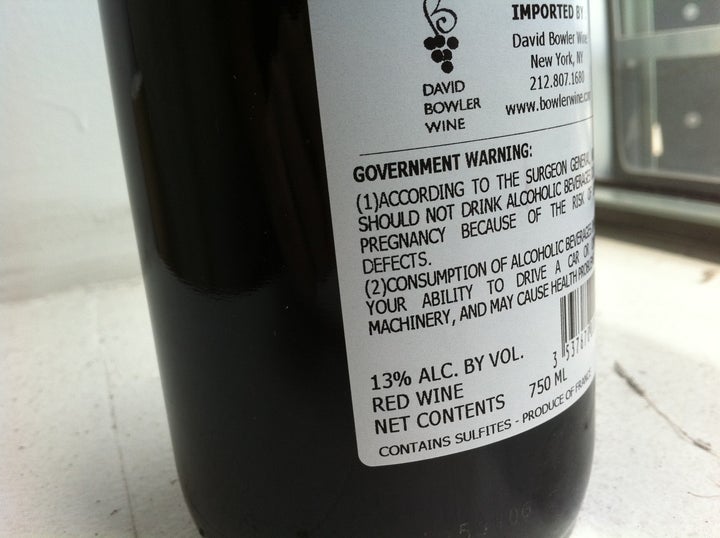
This is a revision and expansion of an article originally published on The Satellite Show.
You're not allergic to sulfites.
Well, probably not.
For some reason the sulfite question has popped up in the wine world a lot recently. I think it's a combination of an increased interest in organic products in general coupled with an insurgent popularity of so-called "natural wine" amongst the vino cognoscenti. Despite copious writings (including by me) on the virtually non-existent health risks of sulfites, a large chunk of the population either: still doesn't know about it; doesn't believe it; or chooses to remain willfully ignorant out of some misguided organic fervor.
Here are the facts:
- Various forms of sulfur have been used as a preservative and stabilizer in wine making, as well as in other foods, including most dried fruits, for a very long time. It's also sometimes used in the vineyard, orchard and garden as a natural pest deterrent and fungicide.
- Sulfites have been deliberately used as a preservative in wine making for something like 1000 years and were inadvertently used at least as far back as Ancient Rome. Romans noticed that wine stored in amphorae that had been dried with lamps or fires between uses spoiled less often.
- Generally speaking, an entire bottle of wine has fewer sulfites than a two ounce serving of dried apricots.
- Although a sulfite allergy exists, it is a very rare and specific anaphylactic allergy resulting in breathing difficulty, swelling and hives--not headaches or nausea.
- Generally speaking, white wine has more sulfites than red wine since red wine has additional natural preservatives--such as tannins from the grape skins--so less sulfur needs to be added.
- Sulfites are a natural part of the wine making process. Even if you add no additional sulfites, they will still be present in measurable quantities in wine. During fermentation, yeasts convert the natural sulfur in wine (in the form of sulfates) into sulfites. This is also why it is virtually impossible to have a USDA Organic wine even without adding a single drop of sulfites to a wine. Except by random fluke, all wines will have more than 10 parts per million (ppm) sulfites, which is the upper threshold allowed for organic wines.
- The human body produces ten times more sulfites in a day than are found in one liter of a typical wine.
In my past experiences as a waiter and wine retailer and in my current career as a wholesaler I've encountered exactly one person with a legitimate sulfite allergy. White wines and lighter red wines gave him hives. He still drank more tannic red wines. I have, however, encountered numerous people who claimed to have a sulfite allergy but failed the basic Lemon test, because:
- Headache was the primary or sole symptom they mentioned.
- Invariably, symptoms were worse with red wine than with white wine.
- They were uncompromisingly certain that sulfites were the issue and would not consider any other sources.
There are innumerable things in wine that cause headache including, of course, alcohol. Red wine contains numerous histamines and there is a general consensus that there is something in many red wines that causes headache in certain individuals, but there is no clear idea what that is yet or even if it is native to red wine or to human DNA. Oak barrels also impart histamines and other compounds that add to the cocktail of chemicals in wine that produces adverse reactions.
Cheap, factory-farmed wine has a lot more stuff in it than small production "farm" wine or "natural" wine. It could have citric acid, oak chips, concentrated grape juice and chemical preservatives above and beyond sulfur. There are nights where I consume an entire bottle (or more) of responsibly-produced wine and feel fine in the morning and other instances where I'll have a glass or two of factory-farmed wine and get a splitting headache.
Unfortunately (but I'm sure to many HuffPost detractors, unsurprisingly), there were exaggerated assertions from anti-sulfur activists published on the Huffington Post in the past, and that doesn't help. If most wines had naturally occurring sulfites of 0-5 ppm, there would be a lot more organic wine out there and more responsible grape growers could trade on the organic name. But the no sulfite-added wines that I've worked with generally have around 15-30 ppm and it is inconsistent year to year since small growers don't have the resources to control and combat free floating sulfur that could blow in from neighboring vineyards.
I believe there is a definitive advantage, in terms of feeling crappy post-drinking, to sipping sustainably farmed, small-production wine that is as natural as it needs to be. But that advantage has nothing to do with the presence or absence of sulfites. Good attentive wine makers use only as much sulfur as necessary to achieve consistency and prevent spoilage, that's it. And again, except for those with an allergy, sulfites are completely safe by every scientific measure I've read.
As a commenter on a past post of mine astutely pointed out, with all this pointed discussion about a simple, natural and safe preservative like sulfur it's funny that we seem to forget that, of all the chemicals in wine to be wary of, the most dangerous by far is that potent poison, alcohol.
(Please note, I'm not a scientist but merely a curious individual. I did, however, consult a scientist: Dr. Tom Mansell, PhD candidate in chemistry at Cornell University and publisher of the wine and science journal Ithacork. I also consulted the excellent article "Sulfites in Wine" by UC Davis Professor Andrew Waterhouse.)